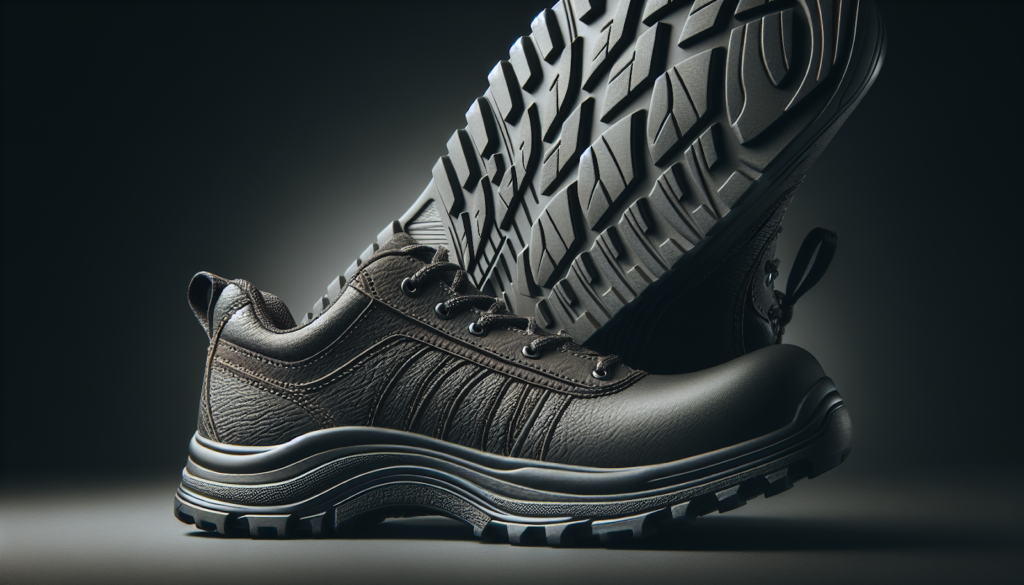Slip-resistant shoes are more than just a footnote in the world of safety footwear; they are a cornerstone for anyone looking to maintain their footing in slippery conditions. Designed with unique outsoles and treads, these shoes are crafted to provide additional grip on surfaces that are wet, oily, or otherwise treacherous. The purpose of slip-resistant shoes is not only to prevent accidents but also to deliver peace of mind to those who wear them in precarious environments.
Understanding non the paramount importance of footwear stability is essential, especially in environments where the risk of slips and falls is elevated. In places like hospitals, restaurants, and construction sites, where split-second mishaps can lead to serious injuries, slip-resistant shoes are not a luxury but a necessity. The nuanced design of these shoes can make a significant difference, helping to reduce workplace accidents and enhance the safety of everyday activities.
Understanding Slip Resistance in Shoes
Key Features of Slip-Resistant Footwear
The efficacy of slip-resistant shoes hinges on critical features like the tread pattern, which is engineered to channel liquids away from the foot, reducing hydroplaning. The sole’s material is also decisive; softer compounds tend to offer better traction on slick surfaces by providing more contact and grip. Furthermore, these shoes are not limited to the outsole – other features such as a supportive design and proper fit also contribute to their overall slip-resistance capability.
How Slip Resistance is Measured and Tested
Slip resistance is quantified through various testing methods that simulate real-world conditions. These tests assess how shoes perform on different surfaces coated with substances like water or oil. One common assessment is the coefficient of friction (CoF) test, which measures the force required to slide an object over a surface at a given pressure. A higher CoF indicates greater slip resistance. Certifications such as ASTM International (American Society for Testing and Materials) and ISO (International Organization for Standardization) standards serve as benchmarks for the safety and performance of slip-resistant footwear.
Slip-Resistant Shoes for the Workplace
Slip-Resistant Shoes for Healthcare Professionals
In healthcare settings, where quick response times are crucial and the risk of spillage is constant, non-slip shoes are a must-have. Healthcare professionals such as nurses and surgeons benefit from shoes that not only resist slips but also support long hours of standing and walking. Quality footwear in these environments can mean the difference between a safe shift and a potentially hazardous incident.
Slip-Resistant Options for Restaurant and Kitchen Staff
Restaurant kitchens are notorious for spills, and with the breakneck pace of service, slip-resistant shoes are indispensable for chefs, waitstaff, and kitchen aides. Footwear designed specifically for these environments often comes with additional features like water resistance and easy-clean materials, ensuring that kitchen staff can focus on delivering exceptional food and service, rather than worrying about their footing.
Industrial and Construction Work Shoes
For industrial and construction environments, where surfaces can be uneven and the presence of materials like oil can compromise traction, specialized slip-resistant work shoes are integral. Such footwear combines robust safety features, including reinforced toe boxes and puncture-resistant soles, with the high-traction outsoles needed to navigate these challenging terrains.
Slip-Resistant Footwear for Daily Activities
Casual Options for Everyday Wear
The demand for slip-resistant footwear transcends the workplace; everyday wear options have also evolved to include non-slip features. From sleek loafers to comfortable sneakers, manufacturers are incorporating slip-resistant outsoles into casual footwear, proving that style and safety can coexist seamlessly. This allows for the transition from work to leisure without compromising on stability and protection against falls.
Athletic Shoes with Enhanced Traction for Sports and Fitness
Athletes and fitness enthusiasts often face slick surfaces in their pursuit of activity, from wet outdoor trails to polished gym floors. Athletic shoes with enhanced traction offer the slip resistance required to maintain performance and safety. Not just limited to the tread, these shoes boast innovations like stability-enhancing designs and materials that deliver the grip needed for various sports and exercises.
Specialized Slip-Resistant Shoes
Shoes for Elderly to Prevent Falls
With age, the risk of falls increases, making the right footwear even more crucial for the elderly. Specialized shoes designed with slip resistance cater to this demographic, focusing on stability and ease of use. Features like Velcro straps and supportive insoles complement the non-slip outsoles in these shoes, ensuring a secure fit and reducing the likelihood of fall-related injuries.
Footwear for Outdoor and Wet Environments
Navigating the great outdoors, particularly in wet conditions, demands footwear that can tackle slippery terrain reliably. Whether it’s for hiking, fishing, or simply walking through a rainy cityscape, specialized outdoor shoes with superior slip resistance are engineered to withstand the elements. Amphibious footwear and water shoes often utilize aggressive tread patterns and siped outsoles to ensure a firm grip on rocks, decks, and trails.
Materials and Design: The Makings of a Non-Slip Shoe
The Role of Tread Patterns and Outsole Materials
The outsole, the part of the shoe that makes contact with the ground, plays a pivotal role in slip resistance. Tread patterns are designed to provide maximum surface area and are often configured to funnel liquids away from the foot. Outsole materials usually consist of rubber or synthetic compounds with varying degrees of softness, which can grip the floor more effectively than harder materials.
Midsole and Insole Contributions to Stability
While outsoles grab the headlines in slip-resistant technology, the midsole and insole contributions can’t be overlooked. A well-cushioned midsole can help disperse the pressure of the foot over a larger area, reducing the risk of slips. Meanwhile, insoles not only provide comfort but can also include elements like arch support and heel cups that improve the wearer’s stability and posture.
How to Choose the Right Slip-Resistant Shoes
Assessing Your Work and Daily Environment Needs
When selecting slip-resistant shoes, it’s critical to evaluate the specific conditions you’ll encounter in both work and daily life. If you work in an environment with oily surfaces, you may need a different level of slip resistance than someone who needs shoes for occasional wet sidewalks. Assess the common substances and situations you’ll face to ensure your footwear will perform when it counts.
Fitting and Comfort Considerations
The best slip-resistant shoe is one that fits well. A shoe that is too tight can decrease traction by not allowing the full surface of the outsole to contact the ground. Conversely, a too-loose shoe can lead to slippage within the footwear, reducing stability. Comfort is also key, as discomfort can distract from safe walking practices and lead to a higher risk of accidents.
Evaluating Shoe Certification and Industry Standards
Certifications and standards are your assurance that the slip-resistant shoes you choose will meet safety expectations. Look for shoes that have been tested and accredited by recognized industry bodies such as ASTM, ISO, or the Occupational Safety and Health Administration (OSHA). These endorsements indicate that the footwear has passed rigorous testing for their anti-slip properties.
Maintenance Tips for Slip-Resistant Footwear
Cleaning and Care for Longevity
To maintain the integrity and effectiveness of slip-resistant shoes, regular cleaning is essential. Dirt and grease can fill the tread grooves and compromise the shoes’ grip. Follow the manufacturer’s instructions for cleaning and care, which may include rinsing with soapy water and scrubbing the soles to remove accumulated grime.
When to Replace Your Slip-Resistant Shoes
Slip resistance can diminish over time as the outsoles wear down. Observing the tread depth is a simple way to gauge when it’s time for a replacement. If the grooves are no longer distinct, or if you notice a decrease in traction, it’s likely time for a new pair. Routinely inspecting your shoes is an important safety practice.
Common Myths and Misconceptions About Slip-Resistant Footwear
Debunking Myths About Traction and Design
There are several myths surrounding slip-resistant shoes, such as the belief that any shoe with a rubber sole offers sufficient traction. Not all rubber soles are created equal, and without the specific tread design geared towards slip resistance, they may not provide the grip necessary for slippery conditions.
The Fact vs. Fiction of Footwear Slip Resistance
Another misconception is the idea that slip-resistant shoes can completely eliminate the risk of falls. While they significantly reduce the risk, no shoe can offer 100% protection against slipping. It is crucial to combine wearing the right shoes with other safety measures, such as mopping up spills promptly and using caution on slick surfaces.
Conclusion
Recapping the Importance of Selecting the Right Slip-Resistant Shoes
In choosing the right slip-resistant shoes, it’s important to remember that they are a vital component in preventing falls and sustaining safety across numerous environments. Whether for work or play, the right pair can offer confidence and stability, particularly in conditions where the risk of slipping is substantial.
Encouraging Safe Practices and Proper Footwear in Hazardous Conditions
Ultimately, while slip-resistant shoes are an invaluable tool in maintaining one’s balance, they should be part of a larger safety protocol that includes awareness and cautious behavior in hazardous conditions. By carefully selecting, maintaining, and wearing the proper slip-resistant shoes, we can all stay steady on our feet, no matter the situation.






